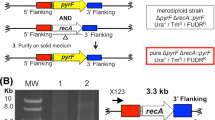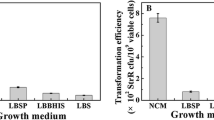Electropermeabilization of Clostridium cellulolyticum was optimized using ATP leakage assays. Electrotransformation was then performed under optimized conditions (6 to 7.5 kV cm−1 field strength applied during 5 ms to a mixture containing methylated plasmids and late exponential phase cell suspensions (10 molecules:1 cell) in a sucrose-containing buffer). Transformants were only obtained when 7 or 7.5 kV cm−1 pulses were applied. Transformation efficiencies evaluated from the growth curves of transformed cells were between 105 and 107 transformants per microgram of plasmid DNA for five different replicon-based plasmids. Restriction nuclease digestion patterns of pJIR418 purified from transformed Clostridia and Escherichia coli were indistinguishable, indicating that heterologous DNA was structurally stable in the Clostridium strain. Copy numbers of 130, 70 and 10 were estimated from purification yield for pCTC1, pKNT19 and pJIR418, respectively.
Journal of Industrial Microbiology & Biotechnology (2001) 27, 271–274.
Similar content being viewed by others
Author information
Authors and Affiliations
Additional information
Received 12 September 2000/ Accepted in revised form 25 November 2000
Rights and permissions
About this article
Cite this article
Tardif, C., Maamar, H., Balfin, M. et al. Electrotransformation studies in Clostridium cellulolyticum . J Ind Microbiol Biotech 27, 271–274 (2001). https://doi.org/10.1038/sj.jim.7000081
Issue Date:
DOI: https://doi.org/10.1038/sj.jim.7000081




